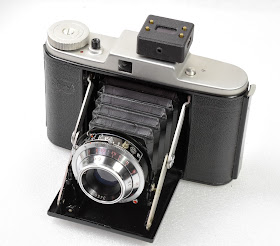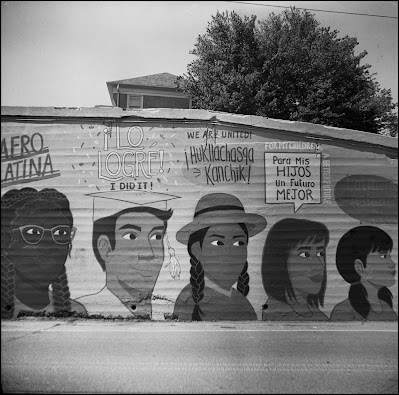 |
| Kudzu, the weed that ate the South- 2023 image |
One of the wonderful aspects of film photography is the ability to develop your film in the way you choose. Maybe you are strictly a one-developer for all films kind of person, or maybe you use a variety of developers, and choose depending on the film being used. Or, maybe, you are one of those renegades that think using a non-traditional developer such as instant coffee is the way into enlightenment. Some photographers eschew traditional photo chemistry for different reasons, but the most common reason is the lower impact on the environment. But another reason is just to see what works, and if it’s more environmentally friendly, all the better. That’s the charm of using film -- there is no single path, and you can choose whatever gives you the results you desire.
I’ll admit that for many years, I stuck with traditional developers, as I wanted results that I could depend upon, and I mostly still do. That’s not a bad thing. If you are accustomed to the results that you get from D-76, Rodinal, or XTOL, or whatever favorite developer, that’s backed by many years of use and predictable outcomes, that’s what you’ll use. Developers made from coffee? Nah! How about botanicals? Nah! Who wants to trust their film to some sketchy home-brewed concoction? Well, the avant-garde photographers and experimenters would like a word. Don’t be tied into the clutches of Kodak, Ilford, or those chemistry peddlers! Create your own developer from whatever the hell you want!
 |
| Orwo NP55, developed in Caffenol, 2019 |
Okay, the last sentence was a little much, but to create your own developer isn’t just throwing jelly at a wall to see what sticks. You need to be able to transform that latent image into a negative, and to do that requires a few components. I am not going to go into the complex photochemistry developers, but the main purpose of the developer is to turn the silver halides in the latent image into metallic silver, which will appear as a darker grain in the gelatin matrix of the film. When properly developed, areas that did not receive any light will be clear, and areas that received light will be in various shades of gray to black. Typically, that action is done by by the developing agent, and traditionally, that agent is phenidone, hydroquinone, or metol. The addition of an accelerator to provide a higher pH, such as borax, sodium carbonate, or sodium hydroxide keeps the developing environment basic to enable the developer to work without depletion before the halides are fully affected. However, Ascorbic Acid (Vitamin C) is also a developer, but one that is not very strong, unless combined with another developing agent. It’s also the least toxic developing agent. A restraining agent is also used to avoid too aggressive development which results in fog. That’s often Potassium bromide or Potassium iodide, but not all developers need them.
Are you confused yet? To replace a commercial developer with a home-brew of less toxicity, you need a chemical that acts somewhat like phenidone, or that of a tanning or staining developer, such as Pyrogallol or Pyrocatechin. Here is where things get interesting. Minute amounts of catechin are found in green tea. If tea might work, what about coffee? Its super power is caffeic acid. Well, that works, but what about plants with green leaves? So, you see where this is heading. The problem is that we don’t know up front, what different plant chemistries are in relation to film developing. But, given the penchant for experimentation, people have found materials that work as well as typical developers, but also with their unique characteristics. Coffee, beer, wine, urine, tea, and various herbs have been used to make developers. On their own, they can’t develop film, because the accelerator and ascorbic acid are needed.
So, on our mission to create a developer, we need:
- Some extract from organic material that contains catechins, caffeic acid, or polyphenols
- Sodium carbonate for the accelerator
- Vitamin C to work with the organic material as the developer.
- maybe a restrainer - Iodized table salt
You have probably heard of Caffenol as a developer, and there are numerous recipes for it. Caffenol works well, but has a few drawbacks, one being the expense of instant coffee, and the foul odor it has can be a real turnoff for some. I have used caffenol a number of times and it is certainly a reliable developer that can be used for film and paper, but it does also stain the emulsion. If you don't already have the ingredients, you can buy some pre-mixed from the Film Photography Project store. I have blogged about Caffenol several times, and it's a good developer if you want to try it out. There are developer recipes that use green tea, and more recently, some photographers have gravitated to experimenting with locally-sourced herbs and leaves that can act as developing agents in concert with the above materials.
In the past year, I have seen some very good results from Beatrice Thornton, a photographer based in California. Her experiments with commonly available leafy plants to act as the basis for developers are quite impressive. (https://www.beatricevictoria.com/writingandreviews) Her work was in the back of my mind when I started working on a project with the invasive Kudzu vine. My premise was to take photographs of Kudzu and use the Kudzu leaves to develop the film. I had absolutely no idea if that would actually work, but I figured that I might at least get some thin negatives, if anything.
 |
| Riverside Drive, Aug. 2023, Leica M2, SHD 100 film |
On June 14, I took a little drive along the French Broad River near Asheville, and found a spot with plenty of Kudzu growing along the roadside. I took some photos of the Kudzu, and picked enough leaves to fill a plastic grocery sack. I then went to some other places that I knew I would find plenty of photogenic Kudzu, and a few worked out, because I was also shooting with two cameras - my Nikon FM3A with Eastman 5231 (expired) for the film to be developed in the Kudzu. My Nikon F was loaded with Kodak HIE IR film (expired 2007), so I needed the leaves to be in strong sunlight.
After I returned home, I put some of the Kudzu leaves into a 1 quart stainless pan and nearly filled it, making sure that I ripped the leaves into smaller pieces to facilitate the process of extracting whatever botanicals I might get. I then poured enough boiling water to fill the pot and cover the leaves, and let it sit covered for about 5 hours.
Making the "Kudzol" developer
I poured the strained yellowish liquid into a plastic container and ended up with 1 liter of extract. To make the developer, I did the following:
1000 ml of Kudzu extract
6 Tablespoons of Sodium Carbonate
2 Tablespoons of Vitamin C (crushed in a pestle from tablets)
1/4 teaspoon of Iodized Salt (restrainer)
The temperature of the liquid at this point was 24°C, and because it was getting late, I decided to go ahead and use it at that temp. With the addition of the other ingredients, the solution was a darker color.
I put the Eastman 5231 in a 500 ml developing tank, and filled the tank with the developer. I decided on a time of 16 minutes, with 3 inversions every 30 seconds. I really had no guide here, as I was just extrapolating from a caffenol recipe and the 24°C temperature. I used a water stop as usual, and then 8 minutes in fixer, and the typical Ilford wash technique.
When I took the reel out of the tank, and unrolled the film, I was thrilled to see that I had negatives! The emulsion was definitely stained by the developer, but what I could see looked quite good. The next morning, I scanned the negatives on my Epson V700 scanner at 3200 dpi. The scans came out quite good with just some minimal tweaking afterwards.
As you can see, these look like any other negative processed in typical chemistry, but with a yellowish tint to the emulsion. Upon closer inspection, I think that if I had gone with 14 or 15 minutes, the negatives might be perfect, but as you can see from the following images, the results are very good. If I were to do this at 20°C, I would estimate the time at 20 minutes. For high-ISO films, you could add a teaspoon of iodized salt or even omit it, but I have not tested it for those films yet. The Eastman 5231 is a silver-rich emulsion with an ISO of 80 (it’s expired film).
 |
| The beginning of the roll. On US23 near Dillsboro, NC |
 |
| The source of the Kudzu leaves |
 |
| slowly enveloping |
 |
| The same truck shown from 2023 just a few days ago |
 |
| reach for the sky |
 |
| young shoots |
 |
| At the end of the roll in my yard. Hosta flowers |
Final thoughts on Kudzu developer
What drove me to this was the “what if?” without worrying about failure. While I had no preconceived idea of the result, I did know that others have used various botanical extracts to develop film. So, I figured that I might get something. I didn’t know what the quality of the results would be, so I am very pleased with what I got. The experiment has taught me to trust my instincts, and to try out the unusual for a change. It also shows that Kudzu can be used for something! So, don’t be afraid to give this a try.
I can't stress this enough...
WARNING - If you are unsure of what vining plant you are pulling leaves from, please take the time to know the difference between Poison Ivy and Kudzu! That applies to any plant that you might harvest to make a concoction with. Know your plants before you start picking anything.
I am not responsible for your mistakes.























